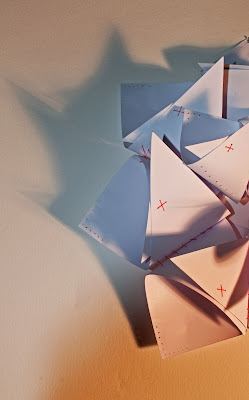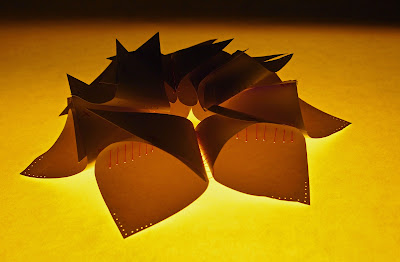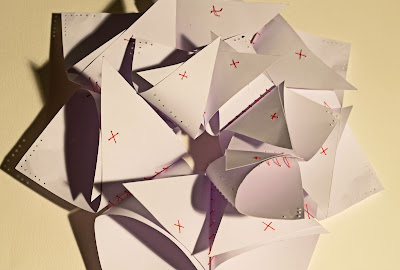I was first inspired by Ron Resch’s paper folding because of the geometric patterns he created, making me want to create a contemporary looking piece by using similar geometric forms. This then lead me onto James Patmore’s work, an artist who created furniture and lighting himself. I liked his NaCI installation light shade in particular as it’s made up of a cluster of geometric shapes. I experimented with trying to create similar, almost cube like, forms from paper but found this difficult as they needed to be properly measured nets for the sides to fold correctly and match up. After trying to use a ready made geometric net but finding it too limited, as well as the fact it wasn’t creating the kind of shape I wanted, I played around with plain pieces of paper to try to and create more simple, individual shapes that fitted together to create a bigger piece.
 I used a red thread to join the forms together, creating a contrast against the pure white of the paper.
I used a red thread to join the forms together, creating a contrast against the pure white of the paper. I experimented with putting my piece onto the light box in the dark room, which gave the piece a nice orange, almost fiery, glow.
I experimented with putting my piece onto the light box in the dark room, which gave the piece a nice orange, almost fiery, glow.I also tried putting LED lights in the center of the piece and inside each segment. Putting them in each segment gave an interesting effect and a different burst of light was projected from each one.
 As well as experimenting with light behind it and amongst it, I projected light onto it to try and create some interesting photographs of the forms and delicate, time consuming, joining method.
As well as experimenting with light behind it and amongst it, I projected light onto it to try and create some interesting photographs of the forms and delicate, time consuming, joining method. Projecting light onto the piece also created some interesting shadows.





















